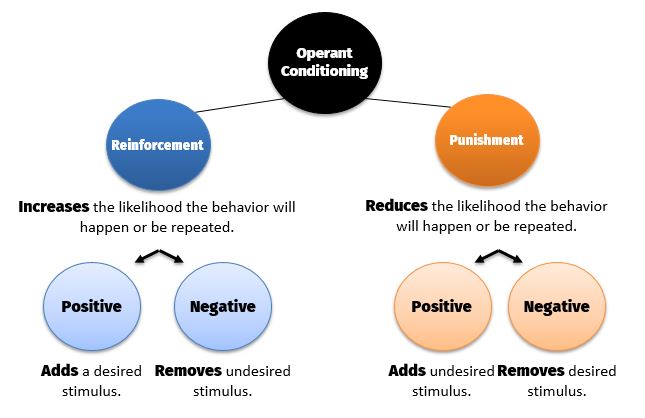Hello my friend, and welcome back for the Part 2 of our discussion on operant conditioning.
This time I would like to guide you on how marketing applies it to influence the behaviour of consumers. I am sure you will identify with many of the examples and recognise that you have been “fooled” before by these practices.
But before we start, shal we do a quick review? In Part 1 we discussed what operant conditioning is: a system of punishments and rewards, used to influence future behaviour of individuals. And in the case of marketing, to influence how consumers behave (e.g., what, when and how to buy).
But in case you need a quick refresh: in operant conditioning we use rewards (also called reinforcements) when we want to certain behaviour to be repeated, or for it to start. And we use punishments when the goal is for individuals to avoid, or to stop a certain behaviour.
Also, both punishments and rewards they can be classified as positive or negative. Positive, when a stimuli is added (to either reward or punish someone) and negative when a stimuli is removed (also to either reward or punish someone). Therefore, there are four main classifications in operant conditioning: positive and negative reinforcements, and positive and negative punishments, as shown on the beautiful figure below which I made just for you:

So… since you are now an absolute master on the rationale of operant conditioning (in case you are still unsure, go back and read the Part 1), let us discuss a series of examples of how marketing applies it.
Ready?
Applications of “Rewards” in marketing
Reinforcements (or rewards) are one of the most effective ways organizations can use to influence future behaviour of consumers. Simply put, people love receiving things “for free” or unexpectedly. Especially if they have value.
So giving consumers a reward for displaying any type of desired behavior (e.g. purchasing high amounts, communicating the brand or through a specific channel) surely influences the likelihood that it will be repeated. Here are a few simple examples:
-
- Tangible products: (1) When a cashier adds a sweet or small gift inside your store bag after you paid for the product. (2) A sweet given by a waiter when someone pays the bill at a restaurant. (3) A free jersey of a football club when a fan becomes an annual member.
- Price: (1) Discount for purchasing through a certain channel (e.g., online), or at a cerain time of the year. (2) Free products or product bundles (“buy two, get one free”) for buying a larger amount of products.
- Services: (1) Free gift wrapping, (2) free delivery, (3) access to relaxing lounge for repeated purchases.

In all these examples, the idea simple: the organisation wants the consumer to repeat the behaviour of purchasing large amount or large values. As a way to induce it, it rewards for your previous behavior.
Negative reinforcement is when a company removes an undesired stimulus in order to reward a consumer, and therefore enhance the chances of future behaviour.
For example, one common reward given by airlines to frequent flight members is the change to have priority to board the plane. In short, they are removing the waiting time in the queue.
I mean, who likes waiting? No one! The waiting time in the queue in a crowded airport is something that consumers do not like at all. Will they enjoy this form of reward? Absolutely!
Applications of “Punishments” in marketing
Positive punishment is when an organisation adds a stimulus to avoid that a certain behaviour will happen in the future, or that they will be stopped. Perhaps the most common application of fees (financial punishment) for undesirable behaviour.
For example, imagine a rental car service: if the driver returns after the deadline, or without sufficient gas, or if the car is damaged, what happens? In all of these, a fee is applied for the undesired behaviour to decrease the likelihood that it will happen again.
So fees is often used for return policies, behavioral policies, brand image and more.
Other common examples in marketing include:
-
- Verbal punishment during a service: stewardess at a plane, complaining to a customer in front of others for being loud.
- Forced leaving from a service environment: the removal of the consumer from the place where the service or the experience is delivered, for not behaving properly. For example, being kicked out of a plane or concert.
Finally, negative punishment is not often applied for marketing purposes (removing a desired stimulus, to reduce the likelihood of future behavior). But perhaps the most common application is when a consumer loses their benefits or advantages gained, usually for not consuming frequently enough.
For example, if you have flown with an airline reguarly (and received milage points as a form of positive reinforcement) and you have now stopped flying with them, you will probably lose those points at a certain deadline. In other words, the company is taking away a desired stimuli (milage points) as a form of punishment.
Loyalty Programs
Lastly, loyalty programs are perhaps the ultimate application of operant conditioning in marketing. In short, loyalty programs are a system of punishments and rewards, carefully designed to maintain consumers in a long-term engagement with the company and induce repeated purchases. And the rationale of loyalty programs is very simple:
- The more you purchase, and the higher the value paid, the more you will be rewarded.
- Examples of positive rewards of loyalty programs:
- Loyalty points, discounts, gifts, wrapping, early access to new products, social recognition, enhanced services, time and more.
- Examples of negative rewards of loyalty programs:
- Skip waiting time in cues (e.g., boarding in planes).
- Examples of positive rewards of loyalty programs:
- If you stop or reduce your purchase behavior, you will be punished (normally through negative punishments).
- Examples of positive punishments:
- Rarely applied.
- Examples of negative punishments:
- Loss of benefits gained earlier (e.g., loyalty points).
- Examples of positive punishments:
But do Loyalty programs actually work?
A study called “Do reward program build loyalty for services? The moderating effect of satisfaction on type and timing of rewards” shows that when consumers are satisfied, they preferred delayed direct rewards of higher values to immediate ones. This makes perfect sense, as if a consumer is satisfied then they will continue the long-term relationship with a company.
However, when they are a dissatisfied, they prefer immediate direct rewards, as they know that they will not maintain that long-term relationship with a company. In sum, loyalty programs are effective mainly if consumers are satisfied.





